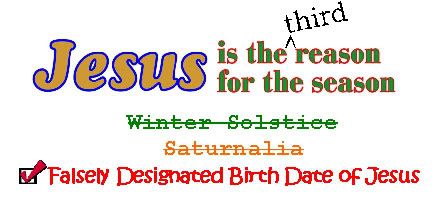Solstice &
Saturnalia &
Christmas, Oh My!
Historical facts are pesky little devils.
Here's a clue for you, fascist fundies:
You can argue an opinion.
You can't argue a fact.
Just because earlier seasonal observances were a lot more fun than yours, to claim them as your own and make up silly untrue slogans is downright hypocritical!

Historians are unsure exactly when Christians first began celebrating the Nativity of Christ. However, most scholars believe that Christmas originated in the 4th century as a Christian substitute for pagan celebrations of the winter solstice. Before the introduction of Christmas, each year beginning on December 17 Romans honored Saturn, the ancient god of agriculture, in a festival called Saturnalia. This festival lasted for seven days and included the winter solstice, which usually occurred around December 25 on the ancient Julian calendar. During Saturnalia the Romans feasted, postponed all business and warfare, exchanged gifts, and temporarily freed their slaves. Many Romans also celebrated the lengthening of daylight following the winter solstice by participating in rituals to glorify Mithra, the ancient Persian god of light (see Mithraism). These and other winter festivities continued through January 1, the festival of Kalends, when Romans marked the day of the new moon and the first day of the month and year. LINKGot that, fascist fundies?
Solstice
Solstice: The times when the Sun is at its furthest from the celestial equator are called the summer and winter solstices and these occur in mid-summer and mid-winter.
In the Northern Hemisphere it is the Summer Solstice which occurs around 21st June each year.
In the Southern Hemisphere the Summer Solstice occurs around December 21st each year.
2004
Equinoxes March 20 06:49 GMT September 22 16:30 GMT
Solstices June 21 00:57 GMT December 21 12:42 GMT
2005
Equinoxes March 20 12:33 GMT September 22 22:23 GMT
Solstices June 21 06:46 GMT December 21 18:35 GMT
LINK
Winter Solstice is the shortest day of the year and the sun is at it's lowest arc in the sky. Astronomers have pinpointed the exact angle to the tilt of the earth to the sun at 23 degrees/27 minutes from the plane of orbit--but to simplify things: Winter Solstice is when (because of this tilt) your hemisphere is leaning farthest away from the sun. It is heralded as a turning point--the day that marks the return of the sun.
Cultures world over perform solstice rituals, usually involving light in some way, and revolved around the fear that the light would not return. Ancient cultures built great architecture aligned to observe and mark solstices and equinoxes.
An example is Stonehenge, a perfect marker for the solstices. A lesser known megalith site is Newgrange in Ireland. This circular stone structure is estimated to be centuries older than Stonehenge. It receives a beam of light deep into it's central chambers at dawn on Winter Solstice--which reveals a series of carvings on a stone basin. A third example is Maeshowe on the Orkney Islands, north of Scotland, which admits a shaft of light at the Winter Solstice setting sun.
As the modern faiths became more common and the pagan (country) faiths less popular, the Christmas holiday season was transplanted onto Winter Solstice. Celebrations involve decorative lights, candles and fires of special logs or certain pine branches. Apple wassailing derives from blessing of the apple trees for bountiful harvests. Even the making of certain special cakes and pastries come from the fruitfulness of nature, the return of life and the return of the sun.
Native Americans had Winter Solstice rites. In Iran, there is a celebration of Yalda, kept by burning fires throughout the night to help the sun and battle the darkness. There are Winter Solstice celebrations in Pakistan, Tibet and China. In Russia there is a Christmas ritual involving candles. The Jewish Festival of the Lights occures around this time of year. LINK
Saturnalia
By the beginning of December, writes Columella, the farmer should have finished his autumn planting. Now, at the time of the winter solstice (December 25 in the Julian calendar), Saturnus, the god of seed and sowing, was honored with a festival. The Saturnalia officially was celebrated on December 17 (a.d. XVI Kal. Ian.) and, in Cicero's time, lasted seven days, from December 17-23. Augustus attempted to limit the holiday to three days, so the civil courts would not have to be closed any longer than necessary, and Caligula extended it to five. Still, everyone seems to have continued to celebrate for a full week, extended, says Macrobius (I.10.24), by the exchange of sigillaria, small earthenware figurines that were sold then.
Macrobius, in his Saturnalia, creates an imaginary symposium among pagan intellectuals that takes place then. There, he offers an explanation for the varying length of the holiday. Originally, it was celebrated on only one day, the fourteenth before the Kalends of January (December 19). With the Julian reform of the calendar, however, two days were added to December, and the Saturnalia was celebrated sixteen days before the Kalends (December 17), "with the result that, since the exact day was not commonly known--some observing the addition which Caesar had made to the calendar and others following the old usage--the festival came to be regarded as lasting for more days than one" (I.10.2). The original day was given over to the Opalia, honoring Ops, who personified abundance and the fruits of the earth, and was the consort of Saturn. As the two deities represented the produce of the fields and orchards, so they also were thought to represent heaven and earth. It was for this reason, says Macrobius (I.10.20), that the festivals were celebrated at the same time, the worshippers of Ops always sitting in prayer so that they touched the earth, mother of all.
In the Roman calendar, the Saturnalia was designated a holy day, or holiday, on which religious rites were performed. Saturn, himself, was identified with Kronos, and sacrificed to according to Greek ritual, with the head uncovered. The Temple of Saturn, the oldest temple recorded by the pontiffs, had been dedicated on the Saturnalia, and the woolen bonds which fettered the feet of the ivory cult statue within were loosened on that day to symbolize the liberation of the god.
It also was a festival day. After sacrifice at the temple, there was a public banquet, which Livy says was introduced in 217 BC (there also may have been a lectisternium, a banquet for the god in which its image is placed in attendance, as if a guest). Afterwards, according to Macrobius (I.10.18), the celebrants shouted "Io, Saturnalia!" at a riotous feast in the temple. LINK
#3
Christmas
Christmas
Although the Gospels describe Jesus’ birth in detail, they never mention the date, so historians do not know on what date he was born. The Roman Catholic Church chose December 25 as the day for the Feast of the Nativity in order to give Christian meaning to existing pagan rituals. For example, the Church replaced festivities honoring the birth of Mithra, the god of light, with festivities to commemorate the birth of Jesus, whom the Bible calls the light of the world. The Catholic Church hoped to draw pagans into its religion by allowing them to continue their revelry while simultaneously honoring the birthday of Jesus. The Eastern Orthodox Church took a slightly different course. By the end of the 4th century the Eastern Church in Constantinople had also begun to acknowledge December 25 as Jesus’ birthday, but it emphasized the celebration of Christ’s baptism on January 6 as the more important holiday.
Over the next 1000 years, the observance of Christmas followed the expansion of Christianity into the rest of Europe and into Egypt. Along the way, Christian beliefs combined with existing pagan feasts and winter rituals to create many long-standing traditions of Christmas celebrations. For example, ancient Europeans believed that the mistletoe plant held magic powers to bestow life and fertility, to bring about peace, and to protect against disease. Northern Europeans associated the plant with the Norse goddess of love, Freya, and developed the custom of kissing underneath mistletoe branches. Christians incorporated this custom into their Christmas celebrations, and kissing under a mistletoe branch eventually became a part of secular Christmas tradition.
During the Reformation of the 16th century, Protestants challenged the authority of the Catholic Church, including its toleration of surviving pagan traditions during Christmas festivities. For a brief time during the 17th century, Puritans banned Christmas in England and in some English colonies in North America because they felt it had become a season best known for gambling, flamboyant public behavior, and overindulgence in food and drink.
Europeans who settled in North America often found they had to change their Christmas celebrations because they could not faithfully recreate the traditions of their homelands. For example, colonists in the American South may have aspired to recreate a sense of the English Christmas. But colonial accounts of Christmas celebrations in the South do not mention the presence of mummers (masked or costumed merrymakers) or waits (musicians or carolers paid to perform at Christmastime), both of which were central figures of the traditional English Christmas. Nor do historical accounts describe settlers engaging in such traditional English customs as feasting on boars’ heads or drinking from wassail bowls (bowls filled with spiced ale or wine).
OK.
Let's recap:
#3 Christmas
#2 Saturnalia
#1 Winter Solstice
Oh, ye Christians of little faith!
Maybe if you actually lived the tenets of your chosen faith, you might set an example for others to follow.
Neither the Romans nor the early Christians were able to stifle the Winter Solstice celebration, but both groups coveted control of the season's revelry.
In the words of Hannibal Lecter, "How do we first begin to covet? We covet that which we see every day."
Hey, fundies!
How about honoring that 10th Commandment? Stop coveting other people's religious observances, OK?







0 Comments:
Post a Comment
<< Home